#Basilica Santa Maria Ad Martyres
Explore tagged Tumblr posts
Photo
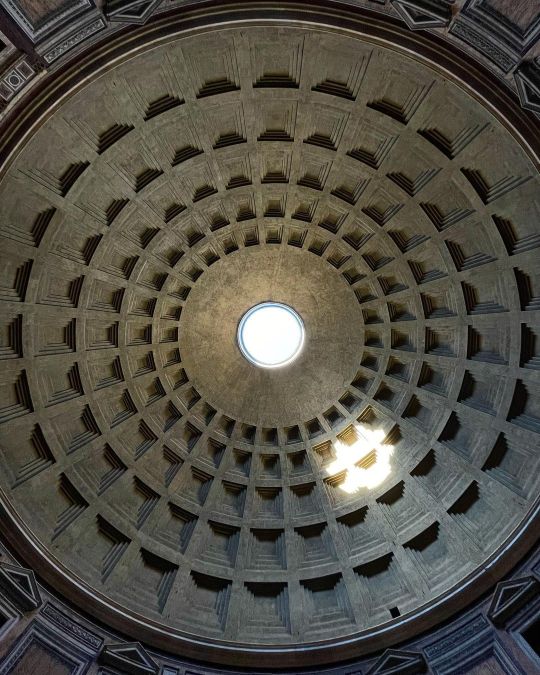
Built in 110AD and still the best velux you’d see this side of the Shannon. By M Agrippa builders for PE house SPQR Ltd who specialised in infrastructure and civils before an expansion. Eventually SPQR was broken up by asset stripping vulture funds and eventually became JJ Rhatigan . . #pantheon #rome #magrippalfcostertivmfecit #lookingup #lookinguparchitecture #jj_urbex #concrete #roma #italia #ilpantheon #radial #rsa_minimal #geometrica #ceilinglight #oculus #jj_architecture #agrippa #rotunda #piazzadellarotonda #romanarchitecture #discoveritaly #romearchitecture #classical #geometry #spqr #forzaitalia (at Pantheon - Basilica di Santa Maria ad Martyres - Roma) https://www.instagram.com/p/Cp7jP9Xss2P/?igshid=NGJjMDIxMWI=
#pantheon#rome#magrippalfcostertivmfecit#lookingup#lookinguparchitecture#jj_urbex#concrete#roma#italia#ilpantheon#radial#rsa_minimal#geometrica#ceilinglight#oculus#jj_architecture#agrippa#rotunda#piazzadellarotonda#romanarchitecture#discoveritaly#romearchitecture#classical#geometry#spqr#forzaitalia
6 notes
·
View notes
Text
adventures in rome part 4
so in the morning of the second day we first took a guided tour by bus around the ancient monuments of the city (mostly)
we saw castel sant’ angelo (on the left) from afar, that has gardens around it shaped like a star and there’s a secret passage connecting it to the vatican through which various popes have escaped peril. its name is taken as “castle of the angels” but more correctly it’s “castle of st. angel”. close by is rome’s palace of justice, the seat of the supreme court of cassation
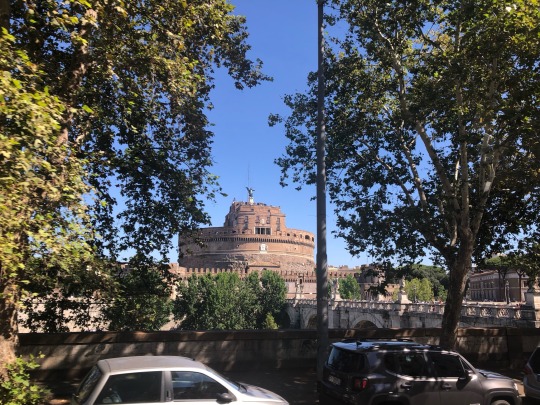
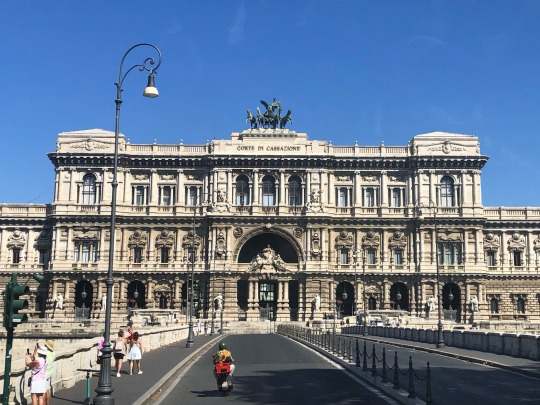
then we reached villa borghese (its entrance on the left), a giant public park with the building being an art museum. in the past all parks were villas bc they actually were; the most powerful families held villas with huge gardens, some of which still survive to this day. the city of rome managed to buy this park and maintain its nature in contrast to some of the other villas where their gardens were uprooted and built.


we drove through part of the park and eventually reached piazza della repubblica, where stands the fountain of the naiads (greek nymphs presiding over bodies of fresh water) and in the back santa maria degli angeli e dei martiri (st mary of the angels and the martyrs) a basilica built inside the ruined baths of diocletian following an original design by michelangelo


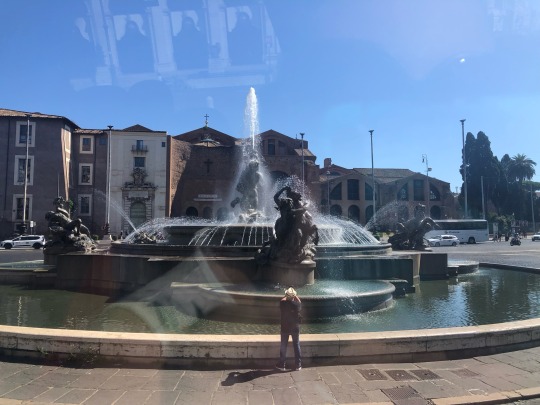
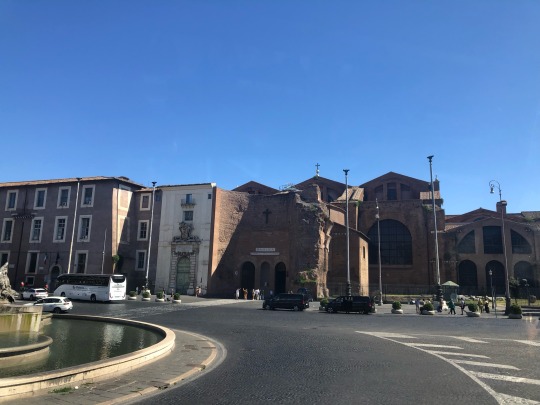
after that we also saw santa maria maggiore (st mary major), one of the first churches built to celebrate virgin mary after, in 431 ad, she was proclaimed mary mother of god by the council of ephesus. the church was built in that immediate aftermath. its ceiling internally is gilded with the first gold brought from peru, which queen isabella donated to the then pope. this was the biggest church before the construction of st peter’s basilica in the vatican
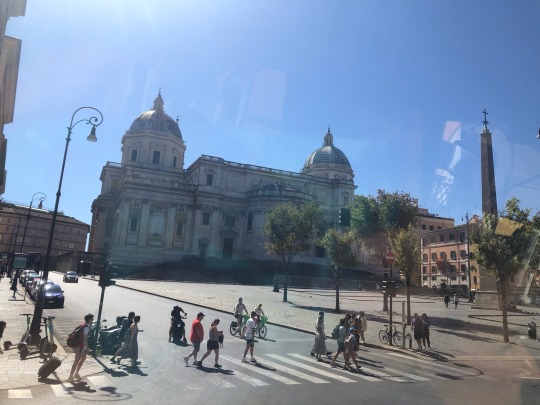
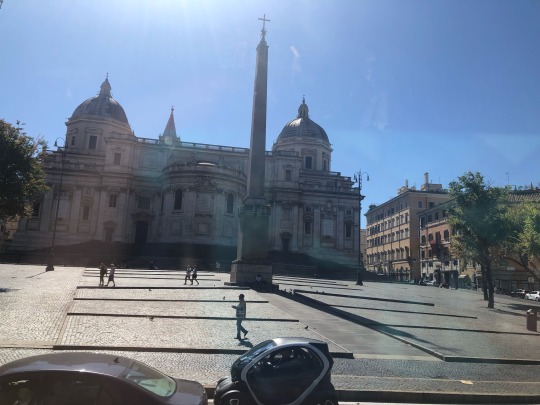
#i’m looking up some info to make sure i’ve got my facts straight#as i’m making these posts#and man it’s so freaking cool finding out even more abt this city#forever in love#ana in rome
3 notes
·
View notes
Text
Today the Church remembers SS. Basilissa and Anastasia, Martyrs.
Orate pro nobis.
Basilissa and Anastasia were described as "Roman matrons of high rank and great wealth". They were disciples of and might have been baptized by the apostles Peter and Paul. When the emperor Nero (54-68 AD) persecuted Christians and gave them over to torture and execution, Basilissa and Anastasia took the bodies of the holy martyrs and gave them reverent burials, including Peter and Paul after their martyrdom in Rome on the same day in 67 AD. The location of the two tombs eventually became St. Peter's Basilica and the Basilica of St. Paul Outside the Walls.
The burials exposed Basilissa and Anastasia to more persecution, and they were arrested for collecting the relics of and burying the bodies of other martyred Christians. They refused to recant their Christian faith and were beheaded with swords by order of Nero in 68 AD, after being tortured, including having their tongues torn out, their skins scraped with hooks, being burned with fire, and their breasts and feet cut off. Their relics are at Santa Maria della Pace Church in Rome. A statue of Basilissa is among the statues that line the colonnade overlooking St. Peter's Square in Rome.
Almighty and everlasting God, who kindled the flame of your love in the heart of your holy martyrs Basilissa and Anastasia: Grant to us, your humble servants, a like faith and power of love, that we who rejoice in their triumph may profit by their example; through Jesus Christ our Lord, who lives and reigns with you and the Holy Spirit, one God, forever and ever.
Amen.

#father troy beecham#christianity#jesus#saints#god#salvation#peace#martyrs#faith#early church#christian persecution
2 notes
·
View notes
Photo
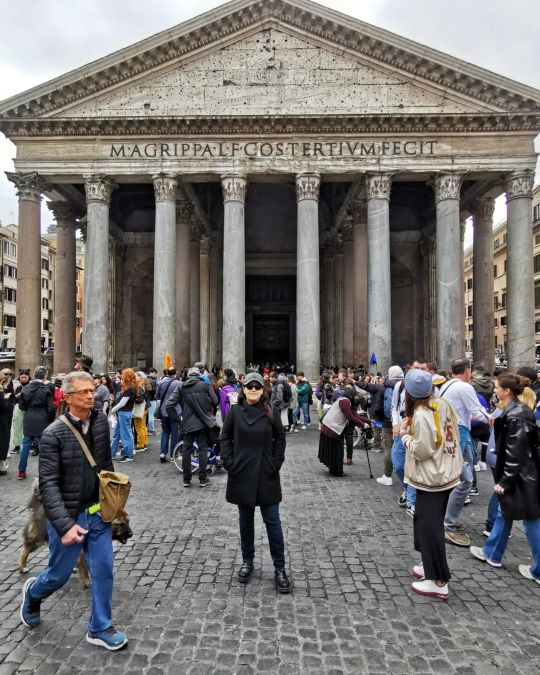
•👄 Il Pantheon è un edificio della Roma antica situato nel rione Pigna nel Centro storico, costruito come tempio dedicato a tutte le divinità passate, presenti e future. Fu fondato nel 27 a.C. da Marco Vipsanio Agrippa, genero di Augusto. Fu fatto ricostruire dall'imperatore Adriano tra il 120 e il 124 d.C., dopo che gli incendi dell'80 e del 110 d.C. avevano danneggiato la costruzione precedente di età augustea. L'edificio è composto da una struttura circolare unita a un portico in colonne corinzie (otto frontali e due gruppi di quattro in seconda e terza fila) che sorreggono un frontone. La grande cella circolare, detta rotonda, è cinta da spesse pareti in muratura e da otto grandi piloni su cui è ripartito il peso della caratteristica cupola semisferica in calcestruzzo. La cupola ospita al suo apice un'apertura circolare detta oculo, che permette l'illuminazione dell'ambiente interno. L'altezza dell'edificio calcolata all'oculo è pari al diametro della rotonda, caratteristica che rispecchia i criteri classici di architettura equilibrata e armoniosa. A quasi due millenni dalla sua costruzione, la cupola del Pantheon rimane la più grande cupola del mondo in calcestruzzo non armato. All'inizio del VII secolo il Pantheon è stato convertito in basilica cristiana, chiamata Santa Maria della Rotonda o Santa Maria ad Martyres, il che gli ha consentito di sopravvivere quasi integro alle spoliazioni apportate agli edifici della Roma classica dai papi. Gode del rango di basilica minore ed è l'unica basilica di Roma oltre a quelle patriarcali ad avere ancora un capitolo. CONTINUA NEI COMMENTI 📍Piazza della Rotonda 00186 Roma, Italia • • • #designme #minuzzerie #tipsminuzforminuz #amofarefoto #amo_scattare #rome🇮🇹 #romecity #arthistory #storiadellarte #cultura #travelcaptures #lovingrome #wheninrome #romacittaeterna #buongiornoroma #instaroma #cittaeterna #romacaputmundi #lagrandebellezza #architecture #ancientrome #romabestphoto #roma_bestphoto #bellezzediroma #romasuperscatti #romaphotogroup #clickfor_roma #beautifuldestinations #architecturephotography #storyofthestreet (presso Pantheon - Piazza Della Rotonda) https://www.instagram.com/p/CpW_c5Hs9k9/?igshid=NGJjMDIxMWI=
#designme#minuzzerie#tipsminuzforminuz#amofarefoto#amo_scattare#rome🇮🇹#romecity#arthistory#storiadellarte#cultura#travelcaptures#lovingrome#wheninrome#romacittaeterna#buongiornoroma#instaroma#cittaeterna#romacaputmundi#lagrandebellezza#architecture#ancientrome#romabestphoto#roma_bestphoto#bellezzediroma#romasuperscatti#romaphotogroup#clickfor_roma#beautifuldestinations#architecturephotography#storyofthestreet
2 notes
·
View notes
Text
Assignment #2
Annotated Bibliography
Dewidar, Khaled M. “The Pantheon.” Research Gate, British University in Egypt, 24 June 2019, https://www.researchgate.net/profile/Khaled-Dewidar/publication/310597898_The_Pantheon/links/5832c05808ae004f74c32e49/The-Pantheon.pdf. Accessed 21 December 2023.
Khalen Dewidar, Professor at The British University of Egypt discusses the religious significance of the Roman Pantheon in correlation to its structural engineering. Khalen addresses a number of significant features that are imperative to my study. We learn about the Ancient Roman religion, architecture, religious tolerance and transition, and cultural heritage. My paper will discuss the historical significance of the monument and its functionality as a church and this resource will aid in looking at the history to tie into the present.
Hannah, Robert. “The Pantheon as a Timekeepers.” El Soliel Temps, University of Otago, December 2009, https://www.elsolieltemps.com/pdf/gnomonica/235.pdf. Accessed 21 December 2023.
Robert Hannah, Professor of Classics at the University of Otago, NZ researched artifacts from the Pantheon and analyzed their significance to both physical purpose and symbolic representation. Hannah focused on the time during the creation of the Pantheon and pre-development. He explored the timekeeping systems and how the monument plays a role in the creation of sundials and gnomonics. Hannah takes the physical evidence and ties it together with the symbolic meanings relating to Roman gods and goddesses. This will be useful in tying into my research paper as we learn about the historical significance in relation to time keeping and how this ultimately shapes the timekeeping we see today.
MacDonald, William Lloyd. The Pantheon: Design, Meaning, and Progeny. Harvard University Press, 2002.
William MacDonald, architectural historian specializing in Roman architecture shares an analysis of the Pantheon identifying historical influences on future architectural developments based on its design and symbolic meanings. MacDonald’s research stems from extensive research and archaeological evidence. During his book he touches on deconstructing the design, breaking down the materials used, and exploring the significance of the various features such as oculus’ and rotunda’s. He later ties in the architectural design to inspiration and influence on future structures such as the St. Paul’s Cathedral in London. This book will assist in addressing the Pantheon’s significance by inspiring future structures. I intend on using the research from the architectural analysis to build the argument.
Marder, Tod A., and Mark Wilson Jones, editors. The Pantheon: From Antiquity to the Present. Cambridge University Press, 2015. Accessed 20 December 2023.
Tod Marder, art historian and Mark Jones, architectural historian present a collection of essays by various scholars researching the Pantheon’s history,
architecture, and cultural significance from different periods. The collection of essays will provide insight into the cultural significance throughout time. This will allow me to gain a better understanding of how the historical significance has evolved along with how society viewed the monument. Essays are drawn from a vast background of contributors including experts in architecture, art history, literary studies, and more. This provides more diversity in perspectives which will be insightful to my research. It is also noted that the essays do carry a general theme of innovation, symbolic interpretation, and cultural representation.
“Pantheon Rome | Basilica of Santa Maria ad Martyres.” Pantheon Roma, https://www.pantheonroma.com/home-eng/. Accessed 21 December 2023.
The “Pantheon Rome '' is a resource for visitors who are interested in visiting the monument in today’s world. While it is limited in information and does have a promotional focus on tourism, it does provide insight on practical information for visiting the site. The resource includes a brief overview of the Pantheon, describing the Pantheon’s features including the oculus, rotunda, coffered ceiling, and bronze doors. Shares information on visiting the sign and touches on a basic level of the cultural and architectural influence. This source is helpful for my research as it provides insight to the functionality of the monument today. It takes a step away from looking at the Pantheon from the lens of what it was when it was built and looks at it as how a tourist would.
Schuddeboom, Feyo L. “The Conversion of Temples in Rome.” Journal of Late Antiquity, John Hopkins University Press, 2017, https://web.archive.org/web/20190127205739id_/https://muse.jhu.edu/article/670877/pdf. Accessed 21 December 2023.
Feyo Schuddeboom, an archaeologist specializing in late Roman and early Christian archaeology challenges the traditional interpretations of the Pantheon in relation to religious conversion. Schuddenboom focuses on rejecting the symbolic emphasis, criticizing the simplistic views and arguing that the focus overlooks the complex social and economic factors during the period. It is beneficial to include this research in my article as there are differing views to take into consideration. The focus of my paper is on the historical significance of the Pantheon and it would be close-minded to assume that everyone shares the same thoughts. As such, I wanted to include a contrary research article to look at the other side of the argument. Schuddenboom does an effective job simulating debate with this article as he challenges established viewpoints and does draw on a wide array of archaeological and historical evidence to base his claims.
“The Pantheon.” University of Washington, 9 August 2004, https://depts.washington.edu/hrome/Authors/asc1/ThePantheon/pub_zbarticle_view_printable.html. Accessed 21 December 2023.
This website provides a general overview of the Pantheon addressing topics of historical background, architectural features, and cultural significance. I will primarily be using this source to get a better understanding on the historical significance of the Pantheon as a dedication to the Roman gods under Emperor Hadrian. While it is limited in depth, it does provide a brief outline of historical aspects to help start off my research.
Thun, Erik. “The pantheon in the middle ages — Rutgers, The State University of New Jersey.” Research With Rutgers, 1 January 2015, https://www.researchwithrutgers.com/en/publications/the-pantheon-in-the-middle-ages. Accessed 21 December 2023.
Erik Thun, a historian specializing in medieval Rome and the Papacy examines the Pantheon during the Middle Ages. There are some conflicting views regarding the usage of the Pantheon during the Middle Ages, Thun argues that its usage during this period was significant and acted as a symbol of imperial continuity for the subsequent rulers. He touches on the religious significance in the evolution from a pagan temple to a Christian church. This source will be useful in looking at a period that was seemingly overlooked by a number of other historians. I intend on using this source to touch on the historical significance during a generally neglected period for this monument.
Waddell, Gene. “Creating the Pantheon.” Lerma, College of Charleston, 24 June 2019, https://en.lerma.it/erma_assets/BookStore/Preview/00012158-preview.pdf. Accessed 21 December 2023.
Gene Waddel, an architectural historian, dives in design and construction of the Pantheon. Waddel challenges the traditional interpretations of the Pantheon’s construction with alternative interpretations based on empirical evidence. Furthermore, there is a focus on the Roman concrete which Waddel highlights as innovative and delves into its composition, casting methods, and structural capabilities. I intend on using this book to look at the historical significance and functionality. One of the challenges I may run into while using this source is the technical language pertaining to architectural concepts.
Williams, Caitlin. “A Study of the Pantheon Through Time.” Union | Digital Works, July 2018, https://digitalworks.union.edu/cgi/viewcontent.cgi?article=1640&context=theses. Accessed 21 December 2023.
Caitlin William explores the Pantheon's cultural and artist influence across different periods. This article will aid my research in increasing my understanding of the cultural and artist impacts as a result of the creation of this monument. Williams also analyzes the transformation into a Christian church and its use throughout history. As my paper addresses the functionality of a church today, this will be assistive in supplementing the additional sources I have analyzing the Pantheon as a church throughout history.
0 notes
Text
Il Pantheon di Roma inaugura l'ingresso a pagamento
Il Pantheon di Roma è il sito culturale più visitato d'Italia e da ora il suo ingresso diventa a pagamento. L'iniziativa, frutto di un accordo siglato tra ministero della Cultura è il Vicariato di Roma, è partita lunedì 3 luglio. Vediamo insieme quanto costa il biglietto, chi lo pagherà e a chi andrà il ricavato. Pantheon di Roma: come funzionerà l'ingresso a pagamento Lo scorso 16 marzo il ministero della Cultura e il Vicariato di Roma hanno stipulato un accordo che prevede l'introduzione di un biglietto a pagamento per la visita del Pantheon. Il costo del biglietto ha diversi importi: il prezzo cosiddetto intero è di 5 euro ed è pagato dai visitatori dai 26 anni in su. I visitatori appartenenti alla fascia d'età tra i 18 e i 25 anni pagheranno solo 2 euro, mentre i minorenni entreranno gratuitamente. Saranno esentati dal pagamento del biglietto le persone disabili, i docenti che accompagnano le scolaresche, i canonici del Capitolo della Basilica, il personale laico e religioso e i residenti a Roma. Oltre che opera architettonica apprezzata da turisti provenienti da tutto il mondo, il Pantheon, il cui vero nome è Basilica Collegiata di Santa Maria ad Martyres, è anche un luogo di culto. Pertanto non sarà visitabile durante le celebrazioni religiose. In quei momenti, il personale addetto interdirà l'ingresso ai visitatori creando attraverso dei cordoni un corridoio che porta alla zona dove si celebrano i riti rendendo inaccessibile quella puramente visitabile. Il tempio dedicato a tutti gli Dei Il Pantheon come lo vediamo oggi fu realizzato presumibilmente tra il 112 e il 124 d.C. sotto il regno dell'imperatore Adriano. L'imperatore lo fece ricostruire, probabilmente, dopo che la precedente struttura, di età augustea, era stata danneggiata dagli incendi dell'80 e del 110 d.C. L'edificio ha pianta circolare ed è unito a un pronao con colonne corinzie divise in tre gruppi: il primo gruppo frontale è costituito da 8 colonne, gli altri due gruppi in seconda e terza fila sono costituiti da quattro colonne. Tutte insieme sorreggono un frontone che probabilmente era decorato con un'iscrizione in lettere di bronzo andate perdute. L'interno circolare è realizzato con spesse mura e circondato da otto grandi piloni. La cupola che la sovrasta è corredata di un'apertura centrale detta oculo da cui entra la luce che illumina l'interno della chiesa. Una delle caratteristiche architettoniche del Pantheon sta nell'armonia delle proporzioni: l'altezza della chiesa, dall'oculo al pavimento, è uguale alla circonferenza della camera circolare. Il monumento più visitato d'Italia Con i suoi 9 milioni di visitatori, come affermato dal ministro della Cultura Gennaro Sangiuliano, il Pantheon è il monumento più visitato d'Italia. La proposta di portare il suo ingresso a pagamento risale già al governo precedente e ora è stata attuata. Il ricavato della vendita dei biglietti per il Pantheon saranno così distribuiti: il 70% andrà al ministero e il 30% alla diocesi di Roma. Il ministero utilizzerà il fondo ricavato per la manutenzione ordinaria e straordinaria del bene, mentre la diocesi lo utilizzerà, oltre che per la manutenzione di chiese di proprietà stata site sul territorio, anche per attività culturali e benefiche. In copertina foto di Olga Kropman da Pixabay Immagine interna foto di Daniel Farkaš da Pixabay Read the full article
0 notes
Text
Per visitare il Pantheon biglietto a 5 euro, romani esclusi
Al Pantheon biglietto di ingresso 5 euro ma diverse categorie potranno comunque accedere gratuitamente. Il 70% del ricavato andrà al ministero della Cultura, il 30 % alla diocesi di Roma. E’ la nuova convezione sul Regolamento d’uso della basilica di Santa Maria ad Martyres, meglio conosciuta come Pantheon. A sottoscrivere l’accordo, il MiC, appresentato dal Direttore Generale della Direzione…
View On WordPress
0 notes
Photo

Pantheon (at Pantheon - Basilica di Santa Maria ad Martyres - Roma) https://www.instagram.com/p/Cpv6GbnjMcgP3b6reYKfWyUngT4jECVlOESE-s0/?igshid=NGJjMDIxMWI=
0 notes
Text
Valentine's Day History
Valentine's Day, also called Saint Valentine's Day or the Feast of Saint Valentine, is celebrated annually on February 14. It originated as a Christian feast day honoring a martyr named Valentine. Through later folk traditions, it has become a significant cultural and commercial celebration of romance and love in many regions of the world.
There are a number of martyrdom stories associated with various Saint Valentines connected to February 14, including an account of the imprisonment of Saint Valentine of Rome for ministering to Christians persecuted under the Roman Empire in the third century. According to an early tradition, Saint Valentine restored sight to the blind daughter of his jailer. Numerous later additions to the legend have better related it to the theme of love: an 18th-century embellishment to the legend claims he wrote the jailer's daughter a letter signed "Your Valentine" as a farewell before his execution another tradition posits that Saint Valentine performed weddings for Christian soldiers who were forbidden to marry.
The 8th-century Gelasian Sacramentary recorded the celebration of the Feast of Saint Valentine on February 14.The day became associated with romantic love in the 14th and 15th centuries when notions of courtly love flourished, apparently by association with the "lovebirds" of early spring. In 18th-century England, it grew into an occasion for couples to express their love for each other by presenting flowers, offering confectionery, and sending greeting cards (known as "valentines"). Valentine's Day symbols that are used today include the heart-shaped outline, doves, and the figure of the winged Cupid. In the 19th century, handmade cards gave way to mass-produced greetings. In Italy, Saint Valentine's keys are given to lovers "as a romantic symbol and an invitation to unlock the giver's heart", as well as to children to ward off epilepsy (called Saint Valentine's Malady).
Saint Valentine's Day is not a public holiday in any country, although it is an official feast day in the Anglican Communion[13] and the Lutheran Church. Many parts of the Eastern Orthodox Church also celebrate Saint Valentine's Day on July 6 in honor of Roman presbyter Saint Valentine, and on July 30 in honor of Hieromartyr Valentine, the Bishop of Interamna (modern Terni).
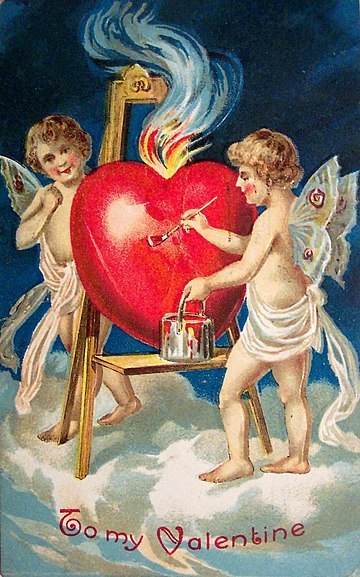
Numerous early Christian martyrs were named Valentine.[16] The Valentines honored on February 14 are Valentine of Rome (Valentinus presb. m. Romae) and Valentine of Terni (Valentinus ep. Interamnensis m. Romae). Valentine of Rome was a priest in Rome who was martyred in 269 and was added to the calendar of saints by Pope Gelasius I in 496 and was buried on the Via Flaminia. The relics of St. Valentine were kept in the Church and Catacombs of San Valentino in Rome, which "remained an important pilgrim site throughout the Middle Ages until the relics of St. Valentine were transferred to the church of Santa Prassede during the pontificate of Nicholas IV [1288 - 1292]".[18][19] The flower-crowned skull of Saint Valentine is exhibited in the Basilica of Santa Maria in Cosmedin, Rome. Other relics are found at Whitefriar Street Carmelite Church in Dublin, Ireland.[20]
Valentine of Terni became bishop of Interamna (now Terni, in central Italy) and is said to have been martyred during the persecution under Emperor Aurelian in 273. He is buried on the Via Flaminia, but in a different location from Valentine of Rome. His relics are at the Basilica of Saint Valentine in Terni (Basilica di San Valentino). Professor Jack B. Oruch of the University of Kansas notes that "abstracts of the acts of the two saints were in nearly every church and monastery of Europe." A relic claimed to be Saint Valentine of Terni's head was preserved in the abbey of New Minster, Winchester, and venerated.
The Catholic Encyclopedia speaks of a third saint named Valentine who was mentioned in early martyrologies under date of February 14. He was martyred in Africa with a number of companions, but nothing more is known about him.
February 14 is celebrated as St. Valentine's Day in various Christian denominations; it has, for example, the rank of 'commemoration' in the calendar of saints in the Anglican Communion. The feast day of Saint Valentine is given in the calendar of saints of the Lutheran Church. In the 1969 revision of the Roman Catholic Calendar of Saints, the feast day of Saint Valentine on February 14 was relegated from the General Roman Calendar to particular (local or even national) calendars for the following reason: "Though the memorial of Saint Valentine is ancient, it is left to particular calendars, since, apart from his name, nothing is known of Saint Valentine except that he was buried on the Via Flaminia on February 14. Therefore, as he remains within the Roman Martyrology, he may recognised optionally during mass outside of Christmastide and Eastertide.
The feast day is still celebrated in Balzan (Malta) where relics of the saint are claimed to be found, and also throughout the world by Traditionalist Catholics who follow the older, pre-Second Vatican Council calendar (see General Roman Calendar of 1960).
In the Eastern Orthodox Church, St. Valentine is recognized on July 6, in which Saint Valentine, the Roman presbyter, is honoured; in addition, the Eastern Orthodox Church observes the feast of Hieromartyr Valentine, Bishop of Interamna, on July 30.[26][27][28]
1 note
·
View note
Photo

#FolkloreThursday: St Valentine - PART I Saint Valentine (Italian: San Valentino; Latin: Valentinus) was a 3rd-century Roman saint, commemorated in Western Christianity on February 14 and in Eastern Orthodoxy on July 6. From the High Middle Ages, his Saints' Day has been associated with a tradition of courtly love. He is also a patron saint of Terni, epilepsy and beekeepers. Saint Valentine was a clergyman – either a priest or a bishop – in the Roman Empire who ministered to persecuted Christians. He was martyred and his body buried on the Via Flaminia on February 14, which has been observed as the Feast of Saint Valentine (Saint Valentine's Day) since at least the eighth century. Relics of him were kept in the Church and Catacombs of San Valentino in Rome, which "remained an important pilgrim site throughout the Middle Ages until the relics of St. Valentine were transferred to the church of Santa Prassede during the pontificate of Nicholas IV". His skull, crowned with flowers, is exhibited in the Basilica of Santa Maria in Cosmedin, Rome. Other relics of him are in Whitefriar Street Carmelite Church, Dublin, Ireland, a popular place of pilgrimage, especially on Saint Valentine's Day, for those seeking love. At least two different Saint Valentines are mentioned in the early martyrologies. For Saint Valentine of Rome, along with Saint Valentine of Terni, "abstracts of the acts of the two saints were in nearly every church and monastery of Europe", according to Professor Jack B. Oruch of the University of Kansas. Saint Valentine of Rome was martyred on February 14 in AD 269. The Feast of Saint Valentine, also known as Saint Valentine's Day, was established by Pope Gelasius I in AD 496 to be celebrated on February 14 in honour of the Christian martyr. #mystique #spiritique #valentines #ValentinesDay #Valentinesweek #HappyValentinesday #ValentinesSeason #valentinesszn #lovers #happyloversday #loversday #loversseason #loversszn #mindfulness #Spiritual #Spirituality #mystical #mystic #mysticisim #StValentine #Galentinesday #galentines #StValentinesDay #sacredhearts #sacredheart #folklorethursday #folklore #folkloreflash #catholiques https://www.instagram.com/p/CouOAuKyqpN/?igshid=NGJjMDIxMWI=
#folklorethursday#mystique#spiritique#valentines#valentinesday#valentinesweek#happyvalentinesday#valentinesseason#valentinesszn#lovers#happyloversday#loversday#loversseason#loversszn#mindfulness#spiritual#spirituality#mystical#mystic#mysticisim#stvalentine#galentinesday#galentines#stvalentinesday#sacredhearts#sacredheart#folklore#folkloreflash#catholiques
0 notes
Video
The Pantheon Dome por Duane Moore
#Basilica Santa Maria Ad Martyres#Pantheon#Rome Italy#CatMan#Duane Moore#Copyright © Duane W. Moore#All rights reserved#DWM_8315_DxO_panouncrop#top-f25#top-f50#top-f75#top-f100
3 notes
·
View notes
Photo
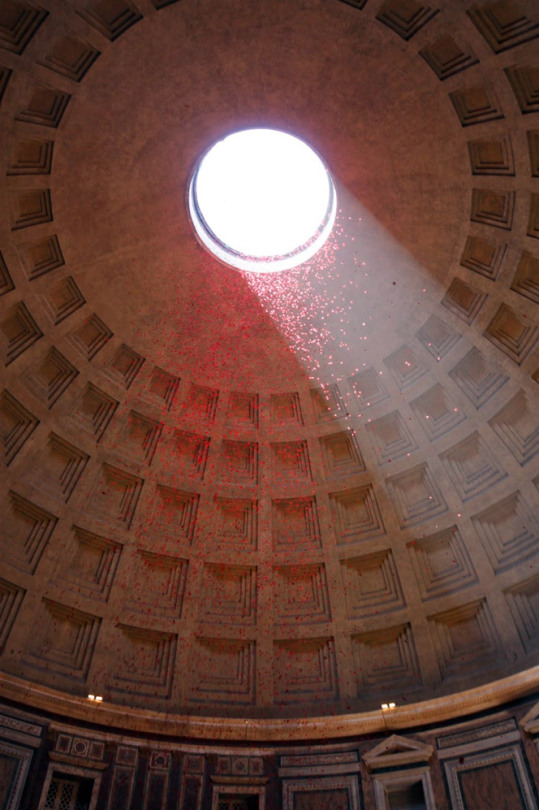
1 note
·
View note
Photo
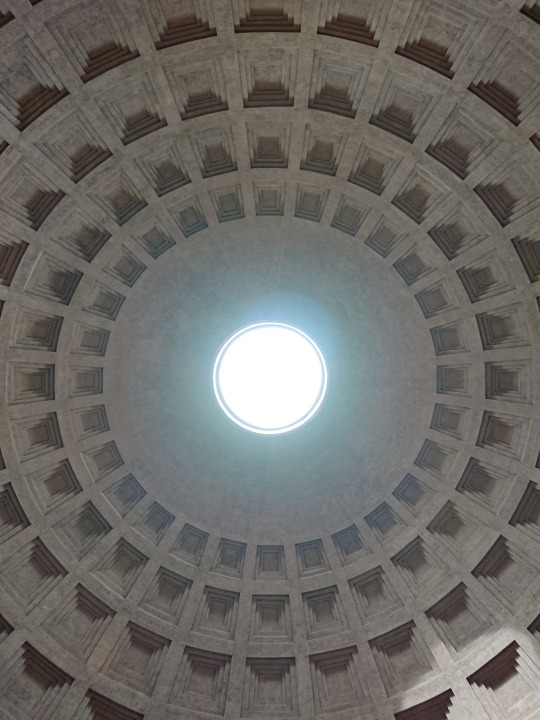
Pantheon. Roma, Italia
#pantheon#roma#italia#temple#Basilica di Santa Maria ad Martyres or Basilica of St. Mary and the Martyrs#trajan#hadrian
0 notes
Photo

Arrivals & Departures Circa AD 226 - 14 February AD 269 Celebrate Saint Valetine’s Day! Celebrate Saint Young Men’s Day!
On manga Saint Young Men Volume 4 Chapter 23, Saint Valentine is described as a saint who wants to protect lovers and kimchi. Buddha met him once on a hot-pot party back in Heaven (this event happens before Jesus and Buddha descends to Earth for their holiday in Japan). In the manga, St. Valentine is also known for his homemade kimchi, which is described as "extremely spicy". Buddha dubbed him as 'patron saint of kimchi.'
Saint Valentine (Italian: San Valentino, Latin: Valentinus) was a widely recognized 3rd-century Roman saint, commemorated in Christianity on February 14. From the High Middle Ages his Saints' Day has been associated with a tradition of courtly love. He is also a patron saint of epilepsy.
Saint Valentine was a clergyman – either a priest or a bishop – in the Roman Empire who ministered to persecuted Christians. He was martyred and his body buried at a Christian cemetery on the Via Flaminia close to the Ponte Milvio to the north of Rome, on February 14, which has been observed as the Feast of Saint Valentine (Saint Valentine's Day) since 496 AD.
Relics of him were kept in the Church and Catacombs of San Valentino in Rome, which "remained an important pilgrim site throughout the Middle Ages until the relics of St. Valentine were transferred to the church of Santa Prassede during the pontificate of Nicholas IV". His skull, crowned with flowers, is exhibited in the Basilica of Santa Maria in Cosmedin, Rome; other relics of him were taken to Whitefriar Street Carmelite Church in Dublin, Ireland, where they remain; this house of worship continues to be a popular place of pilgrimage, especially on Saint Valentine's Day, for those seeking love. For Saint Valentine of Rome, along with Saint Valentine of Terni, "abstracts of the acts of the two saints were in nearly every church and monastery of Europe", according to Professor Jack B. Oruch of the University of Kansas.
Saint Valentine is commemorated in the Anglican Communion and the Lutheran Churches on February 14. In the Eastern Orthodox Church, he is recognized on July 6; in addition, the Eastern Orthodox Church observes the feast of Hieromartyr Valentine, Bishop of Interamna, on July 30. In 1969, the Roman Catholic Church removed his name from the General Roman Calendar, leaving his liturgical celebration to local calendars, though use of the pre-1970 liturgical calendar is also authorized under the conditions indicated in the motu proprio Summorum Pontificum of 2007. The Roman Catholic Church continues to recognize him as a saint, listing him as such in the February 14 entry in the Roman Martyrology, and authorizing liturgical veneration of him on February 14 in any place where that day is not devoted to some other obligatory celebration, in accordance with the rule that on such a day the Mass may be that of any saint listed in the Martyrology for that day.
3 notes
·
View notes
Video
youtube
Concert for Organ and Voice at the Pantheon in Rome. Review
The audience, which crowded the basilica, appreciated, in particular, the masterly direction of Maestro Dmitry Morozov at the Pantheon in Rome.

Steps to foster Cultural exchange initiatives, which anticipate and inaugurate important future projects. Honoring the past, building the future.

Bodies engaged in this first phase: Embassy of Ukraine to the Holy See in Italy, Pontifical Institute of Sacred Music (PISM), Perinsigne College of the Collegiate Basilica of Santa Maria ad Martyres al Pantheon, Tota Pulchra Association.
#future projects#cultural exchange#cultural experiences#Giancarlo Antonini#enterteinment#art forms#culture and society#culture and history#Ukraine
2 notes
·
View notes
Text
The Caelian
The Caelian Hill, the largest of the seven, has formed part of the city since the seventh century BC. This popular suburb began to bristle with rented apartment blocks (Latin: insulae) after the Great Fire in AD 64 supposedly started by Nero (54-68). Devastated by the Normans under Robert Guiscard at the start of the Middle Ages, it was abandoned by its inhabitants, who migrated to the banks of the Tiber. The Caelian remained a stretch of countryside at the gates of Rome until the nineteenth century. Today, with its vegetable gardens and churches, the hill resembles a piece of the provinces misplaced inside the city.

In Antiquity, processions took the Via Triumphalis to the Colosseum, from where they continued to the forums in the city's heart. Near this street stood the family house of Gregory the Great (590-604), who turned the building into a convent dedicated to St. Andrea. The site is now occupied by the church of San Gregorio Magno with its wide stairway. Not far off, on a quiet square, is the impressive basilica Santi Giovanni e Paolo, commissioned by senators in the fourth century and consecrated to the martyrs St. John and St. Paul. Its fine bell tower, porch and modest colonnade are twelfth century, while the interior was decorated from 1725-1734.
Go down the steps at the west end of the right aisle to see the house said to have belonged to John and Paul, with its frescos which transport the visitor back to the dawn of Christianity. On the way to San Clemente will be found a number of other very old churches. First is Santa Maria in Domenica (ninth century), with its almost rural charm; then Santo Stefano Rotondo (fifth century), whose circular design takes its inspiration from the Church of the Holy Sepulchre in Jerusalem.
1 note
·
View note